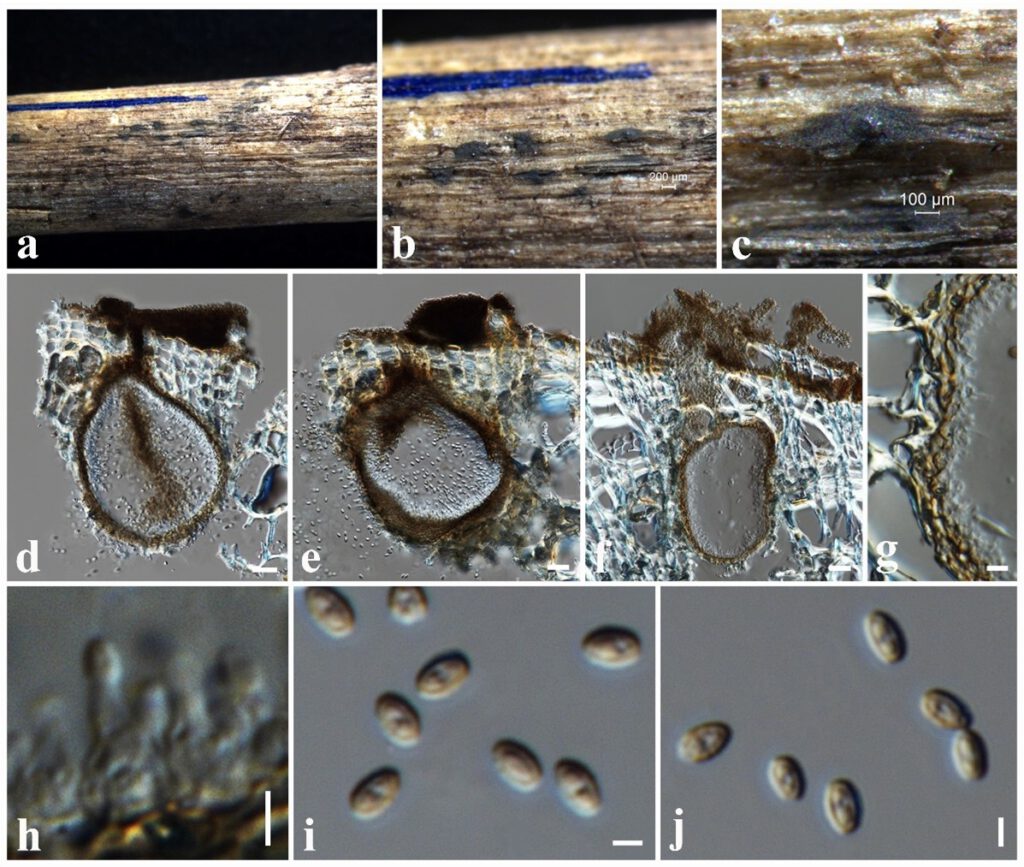Neoroussoella thailandica N.I. de Silva, Lumyong & K.D. Hyde, sp. nov.
MycoBank number: MB 559521; Index Fungorum number: IF 559521; Facesoffungi number: FoF 10719; Fig. 6.33
Etymology: The epithet ‘thailandica’ referring to the country (Thailand) where the specimen was collected.
Holotype: MFLU 18-1323
Saprobic on dead twigs attach to Magnolia sp. Sexual morph: Undetermined. Asexual morph: Coelomycetes. Conidiomata 130–190 μm high × 80–150 μm diam. ( = 160 × 120 µm, n = 10), pycnidial, solitary to gregarious, unilocular, brown to black, immersed to erumpent, ostiolate. Ostiole papillate, central, circular. Conidiomata wall 8–12 µm wide, composed of thick-walled, dark brown cells of textura angularis; inner layer thin, hyaline. Conidiophores usually reduced to conidiogenous cells. Conidiogenous cells 3–5 × 1–3 µm ( = 4 × 2 µm, n = 20), phialidic, ampulliform to cylindrical, hyaline, smooth-walled. Conidia 3–5 × 2–3 μm ( = 4 × 2.3 μm, n = 40), initially hyaline, becoming pale brown when mature, oblong to ovoid, straight, both ends broadly rounded, aseptate, smooth-walled.
Culture characteristics – Colonies on PDA reaching 20 mm diameter after 1 weeks at 25°C, colonies from above: grey, circular, flat, slightly raised, dense at the centre, white at the margin; reverse: brown from the centre of the colony, cream at margin.
Material examined – THAILAND, Chiang Mai Province, dead twigs attached to the host plant of Magnolia sp. (Magnoliaceae), 8 February 2018, N. I. de Silva, NI258 (MFLU 18-1323, holotype), living culture, MFLUCC 18-0712.
Notes – According to the multi-gene phylogeny (LSU, SSU, ITS, tef1 and rpb2), Neoroussoella thailandica (MFLUCC 18-0712) constitutes an independent lineage sister to a subclade containing N. clematidis and N. fulvicomae with 100% ML and 1.00 BYPP support. Neoroussoella thailandica can be distinguished from N. fulvicomae in having thick conidiomatal wall (8–12 µm vs 12–18 µm) and phylogeny evidence (Phukhamsakda et al. 2020). A comparison of the 505 nucleotides across the ITS (+5.8S) gene region of Neoroussoella fulvicomae and N. thailandica (MFLUCC 18-0712) shows 24 base pair differences (4.75%). In addition, there are 21 base pair differences between Neoroussoella clematidis and N. thailandica (MFLUCC 18-0712). However, we are unable to compare the morphology differences with Neoroussoella clematidis, since it has only sexual morph (Phukhamsakda et al. 2020).

Figure 6.33 Neoroussoella thailandica (MFLU 18-1323). a The specimen. b, c Appearance of conidiomata on substrate. d–f Vertical sections through conidioma. g Conidiomatal wall. h Conidiogenous cells. i, j Conidia. Scale bars: b = 200 μm, c = 100 μm, d–f = 20 μm, g = 5 μm, h–j = 2 μm.
